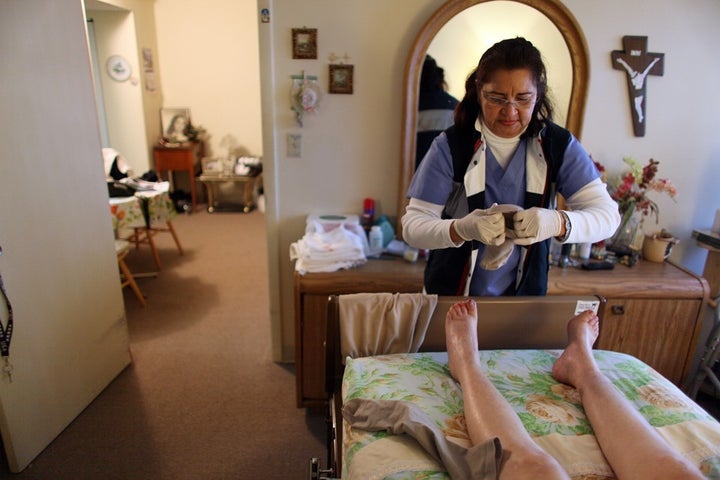
A home-care worker in Miami helps her client get dressed.
By Annie Lowrey
For six weeks, LaTanya Thomas, a personal-care assistant in Minneapolis, worked without pay, helping to clean, dress and feed her client. She and her colleagues asked their boss where their paychecks were. They spoke with the bank. They accepted five- or 10-dollar bills as a little something to tide them over, she said, rolling their eyes when their boss promised that their checks would be cleared by Monday and when she told them to go sign up for food stamps. They threatened to quit. Eventually, some of them did, and eventually, the company went bankrupt. (Its lawyers did not respond to requests for comment.)
“I hung in there because of the client I was taking care of,” Thomas told me. “His other [personal-care assistants] had quit because they couldn’t work without pay. But he was on a special program, and I was the only one left who could take care of him.” That decision ultimately cost her $4,000 in lost wages, she estimated.
Home-health and personal-care work is one of the country’s fastest-growing occupational sectors. But it is one marked by low pay and meager benefits, a problem that might become more urgent as the U.S.’s population continues to age. On top of that, care workers face high rates of wage theft, tax and benefits misclassification, and employer fraud, according to a new report from the National Employment Law Project (NELP), a think tank and advocacy organization.
RELATED: The Forgotten Providers
NELP surveyed more than 3,000 personal-care and home-health workers, from nearly every U.S. state, asking questions about their pay schedules and relationship with their employers. A majority of respondents said that they often worked after-hours, without pay. Two in five said they never received overtime payments, even when they worked more than 40 hours per week. Four in five said they did not have a paid sick-day benefit. A quarter were potentially misclassified as independent contractors.
“There were parts that were not particularly shocking, about poor working conditions, low wages, and the challenges these workers face every day just to stay in this field,” Caitlin Connolly, one of the report’s authors, said. “For me, the more startling pieces were in terms of the stark differences in insurance coverage, paid time off, retirement coverage, and training opportunities.”
Thomas, for instance, alleged two incidents of wage theft during her time as a personal-care assistant. “People in this occupation do not even know it’s wage theft,” she told me. “One lady was working overtime, and they cut her regular per-hour pay. I said, ‘That’s wage theft!’ There’s no way they can cut your regular pay so they aren’t getting you a real time-and-a-half.”
The workers’ complaints centered on low wages and a lack of training, among other issues. In the NELP’s study, most respondents reported making between $7.25 an hour, the federal minimum wage, and $15 an hour. Four in five said they got fewer hours than they requested, too. Given those pay rates, about half of personal-care workers rely on programs like the Supplemental Nutrition Assistance Program, Medicaid, and the Temporary Assistance for Needy Families program — itself often difficult to get and penurious with benefits — to get by.
Thomas and other respondents said that personal relationships with their clients kept them on the job, despite the low wages, difficult working conditions, and fraud. “I’ve worked with a 97-year-old woman for the past two years. I try to treat her with so much tender loving care and she always reminds me of how much she loves me,” one worker said in the report. “I help to lift up her spirits. Home care is not just about going by the care plan. It doesn’t say ‘Comfort her’ or ‘Make her feel like she’s a part of society.’”
RELATED: Who Will Care for America’s Seniors?
Improving training programs for personal-care workers might help both with the quality of the work and the quality of client life, the report indicated. The vast majority of workers said they wanted more training to improve their skills and better serve their clients. That might help with the country’s health-care cost crisis, as well. “Many acute, long-term illnesses can be cared for in the home. This was never really a babysitting job,” said Anastasia Christman, a senior policy analyst at NELP. “These workers see it as, and want to become, more specialized, to provide people with the best service for specific conditions and letting them remain in the home.” Connolly added: “I don’t want to over-medicalize the profession, but there are untapped opportunities there.”
“The vast majority of workers said they wanted more training to improve their skills and better serve their clients.”
Even absent that upskilling of the workforce, the report stressed the need for bolstering workplace protections, improving pay rates, boosting unionization rates, addressing labor misclassification and putting in place more stringent rules on time off and benefits to aid all workers. And labor experts and state officials have long advocated for more oversight of firms supplying home-care workers, which are often subject to far less scrutiny than nursing homes and medical facilities. “If you train people well in the job, they’ll do well,” Thomas said. “If you pay people right, they’ll continue to work.”
This story originally appeared on TheAtlantic.com.
More from The Atlantic: Why Happy People Cheat, The First White President
